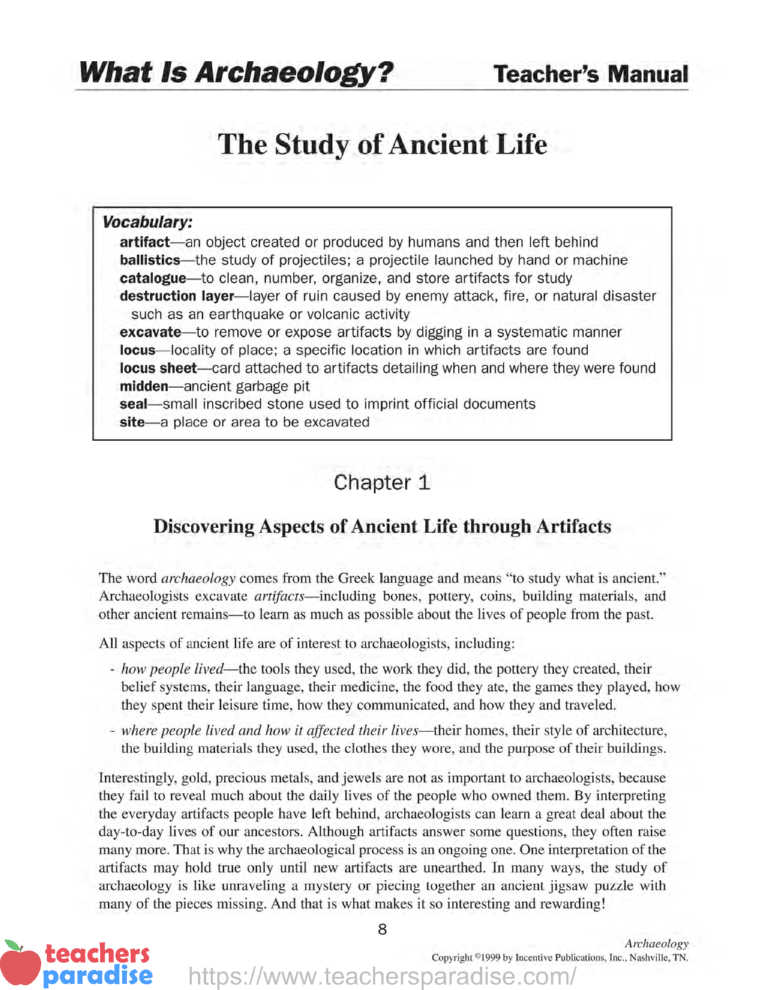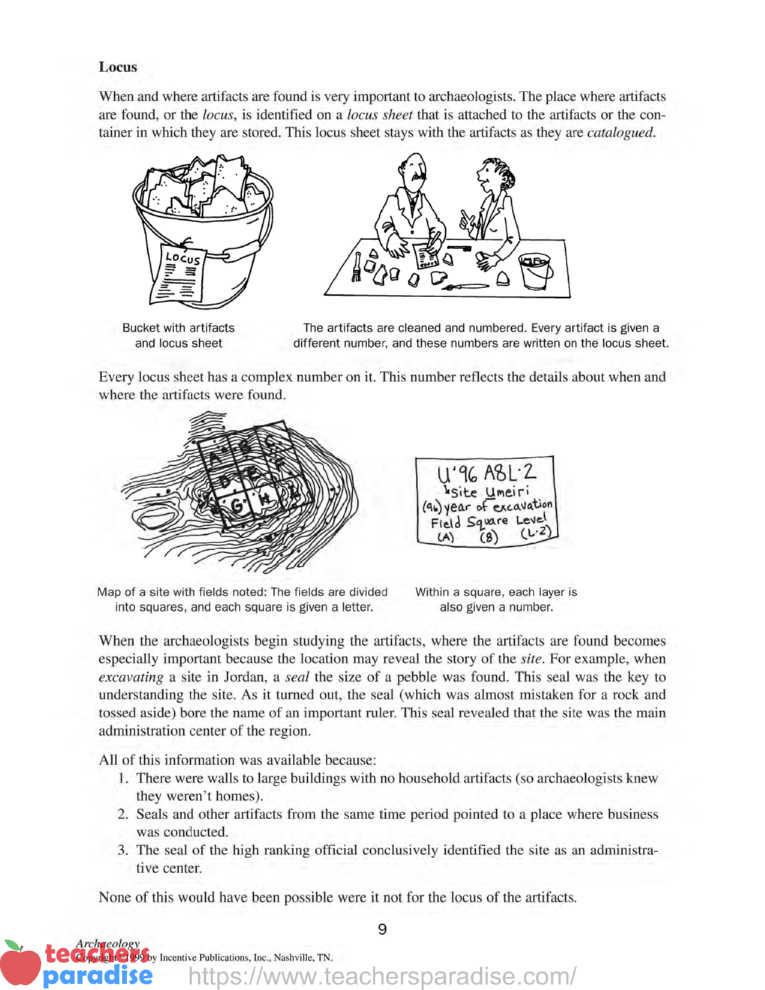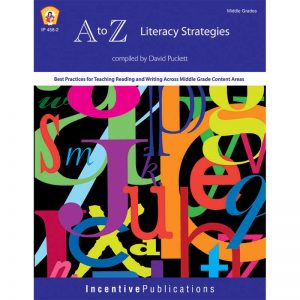What Is Archaeology? Teacher’s Manual
The Study of Ancient Life
Vocabulary:
artifact—an object created or produced by humans and then left behind
ballistics—the study of projectiles; a projectile launched by hand or machine
catalogue—to clean, number, organize, and store artifacts for study
destruction layer—layer of ruin caused by enemy attack, fire, or natural disaster such as an earthquake or volcanic activity
excavate—to remove or expose artifacts by digging in a systematic manner
locus—locality of place; a specific location in which artifacts are found
locus sheet—card attached to artifacts detailing when and where they were found
midden—ancient garbage pit
seal—small inscribed stone used to imprint official documents
site—a place or area to be excavated
WORKSHEET & Sample PDF Activity
Sample PDF Activity

Chapter 1
Discovering Aspects of Ancient Life through Artifacts
The word archaeology comes from the Greek language and means “to study what is ancient.”Archaeologists excavate artifacts—including bones, pottery, coins, building materials, and other ancient remains—to learn as much as possible about the lives of people from the past.
All aspects of ancient life are of interest to archaeologists, including:
- how people lived—the tools they used, the work they did, the pottery they created, their belief systems, their language, their medicine, the food they ate, the games they played, how they spent their leisure time, how they communicated, and how they and traveled.
- where people lived and how it affected their lives—their homes, their style of architecture,the building materials they used, the clothes they wore, and the purpose of their buildings.
Interestingly, gold, precious metals, and jewels are not as important to archaeologists, because they fail to reveal much about the daily lives of the people who owned them. By interpreting the everyday artifacts people have left behind, archaeologists can learn a great deal about the day-to-day lives of our ancestors. Although artifacts answer some questions, they often raise many more. That is why the archaeological process is an ongoing one. One interpretation of the artifacts may hold true only until new artifacts are unearthed. In many ways, the study of archaeology is like unraveling a mystery or piecing together an ancient jigsaw puzzle with many of the pieces missing. And that is what makes it so interesting and rewarding!
Locus
When and where artifacts are found is very important to archaeologists. The place where artifacts are found, or the locus, is identified on a locus sheet that is attached to the artifacts or the container in which they are stored. This locus sheet stays with the artifacts as they are catalogued.
Every locus sheet has a complex number on it. This number reflects the details about when and where the artifacts were found.
When the archaeologists begin studying the artifacts, where the artifacts are found becomes especially important because the location may reveal the story of the site. For example, when excavating a site in Jordan, a seal the size of a pebble was found. This seal was the key to understanding the site. As it turned out, the seal (which was almost mistaken for a rock and tossed aside) bore the name of an important ruler. This seal revealed that the site was the main administration center of the region.
All of this information was available because:
- There were walls to large buildings with no household artifacts (so archaeologists knew they weren’t homes).
- Seals and other artifacts from the same time period pointed to a place where business was conducted.
- The seal of the high ranking official conclusively identified the site as an administrative center.
None of this would have been possible were it not for the locus of the artifacts.

Archaeology – Table of Contents Incentive Publications IP4361
Preface – vii
I. What Is Archaeology?
THE STUDY OF ANCIENT LIFE
Chapter 1—Discovering Aspects of Ancient Life through Artifacts – 8
Activity Pages 10–12
Student Page 111
Chapter 2—Who’s Who – 13
Activity Page 16
Student Pages 112–113
HOW DO WE KNOW ABOUT THE PAST?
Chapter 3—Deciphering Ancient Writing – 17
Activity Pages 24–27
Student Pages 114–115
Chapter 4—Historian Accounts – 28
Activity Pages 31–33
Student Page 116
Chapter 5—Learning from Ancient Art – 34
Activity Pages 39–40
Student Pages 117–118
Chapter 6—Time Capsules: Sites Frozen in Time – 41
Activity Pages 44–45
Student Pages 119–120
II. Artifacts
WHAT IS AN ARTIFACT?
Chapter 7—Material Remains – 46
Activity Pages 47–48
Student Page 121
WHERE ARTIFACTS ARE FOUND
Chapter 8—How Artifacts Become Buried – 49
Activity Page 51Student Page 122Chapter 9—How Artifacts Are Preserved – 52
Activity Pages 57–58
Student Pages 123–124
WHAT ARTIFACTS REVEAL
Chapter 10—Pottery Speaks – 59
Activity Page 63
Student Pages 125–127
III. Going on a Dig
GETTING READY TO DIG
Chapter 11—Tools, Customs, and Daily Schedule – 64
Activity Page 66
Student Pages 128–130
WHERE AND HOW TO DIG
Chapter 12—Surveying and Digging – 67
Activity Page 71
Student Page 131
RECORDING PROGRESSChapter 13—Stratigraphy and Field Notes – 72
Activity Pages 74–75
Student Pages 132–134
UNDERWATER ARCHAEOLOGY
Chapter 14—Finding and Excavating Shipwrecks – 76
Activity Page 79
IV. Interpreting Finds
DATING AND CONSERVING ARTIFACTS
Chapter 15—Context, Scientific Procedures, and Evolution of Objects – 80
Activity Pages 84–85
Student Page 135
Chapter 16—Conserving Artifacts – 86
Activity Page 90
Student Page 136
V. Famous Finds, Mysteries, and Dilemmas
FAMOUS ARCHAEOLOGISTS, SITES, AND FINDS
Chapter 17—Famous Finds, Mysteries, and Questions – 91
Activity Page 97
VI. Experimental Archaeology
Chapter 18—Hands-on Approach to Archaeology – 98
EAT AN ANCIENT MEALActivity Page 100
Student Page 137
DRESS LIKE AN ANCIENT GREEK, ROMAN, OR EGYPTIANActivity Page 101
Student Page 138
TIME CAPSULESActivity Page 102
Student Pages 139–140
MOSAICS, FRESCOES, AND MOREActivity Page 102
MODELSActivity Page 102
CREATE AND EXCAVATE A SITE
Activity Pages 103–104
ARCHAEOLOGICAL CONFERENCE AND MUSEUM
Activity Page 104
VII. Assessment
PRETEST AND/OR POST-TEST
Teacher Pages 105–107
Student Pages 108–110
VIII. Glossary – 141
IX. Bibliography – 144























